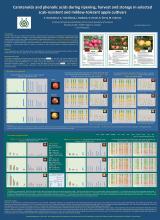The aim of this study was to characterise the changes in concentration and composition of antioxidants during ripening, harvest and after 3 and 6 months of storage in three commercially successful scab-resistant and powdery mildew-tolerant apple cultivars selected in the Institute of Experimental Botany. The detailed description of free and glycosylated phenolic acid profiles and content of 6 selected carotenoids - neoxanthin, violaxanthin, antheraxanthin, lutein, zeaxanthin and ß-carotene will serve for outcomes of major characteristics of these apple cultivars. The information dealt with the concentration and composition of antioxidants in selected apple cultivars is aimed at consumers in view of health benefits of phenolic compounds and carotenoids.
Carotenoids were mainly present in apple peels. The content of carotenoids increased during ripening and reached the highest level in harvested apples, then it decreased during storage. The ratio between individual carotenoids did not change during storage. Fully regulated storage conditions (in ULO boxes) were able to prolong the time of storage and moreover to reduce the lost of carotenoids in stored apples.
Chlorogenic acid represented 98 – 100% of free phenolic acids in peels and fleshes of apples during ripening, harvest and storage. High level of free phenolic acids in non-mature apples declined during ripening and then their content increased again during storage. The effect of different storage conditions was not found. Spectrum of glycosylated phenolic acids in peels and fleshes was broader then spectrum of free ones. The changes in the content of glycosylated phenolic acids in apples during ripening were smaller then in free ones. The concentration of glycosylated phenolic acids increased in harvest and during storage – especially in apple peels. Protocatechuic acid was the main glycosylated phenolic acid in peel; caffeic acid represented the main glycosylated phenolic acid in apple fleshes. The effect of storage conditions was not obvious – the increase of glycosylated phenolic acid contents at the end of storage could be linked with the damage of fruits due to worse storage conditions.

